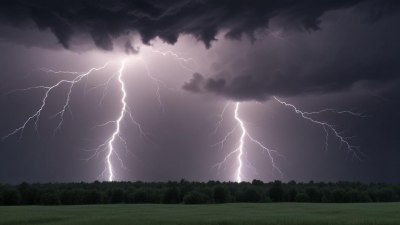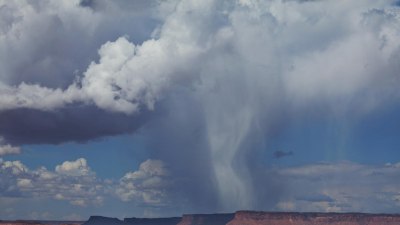Why Some Raindrops Fall Faster Than Others
Explore the science behind raindrop dynamics and understand why some fall faster than others.

Raindrops are a common phenomenon in our daily lives, yet the intricate science behind their formation and behavior is often overlooked. When we look up at the sky and witness the rain spilling down, it might seem like every raindrop falls at the same speed. However, this is a misconception. The reality is that numerous factors contribute to the varying speeds at which raindrops fall to the ground. In this article, we will delve deep into the reasons why some raindrops fall faster than others.
The Basics of Raindrop Formation
To understand why some raindrops fall faster, we first need to explore how raindrops are formed. Rain begins in the clouds, where tiny water droplets accumulate. These droplets cluster together and grow larger due to condensation. Once they reach a certain size, they overcome the upward forces caused by air currents and begin to descend. The process is a delicate balance between gravity, air resistance, and the characteristics of the droplets themselves.
Gravity’s Role in Raindrop Descent
Gravity is the primary force acting on falling raindrops. It's the reason why raindrops accelerate downwards as they fall. The larger the droplet, the more gravitational force it experiences, and thus, the faster it descends. This leads us to one of the key reasons why some raindrops fall faster: their size. Larger raindrops will experience greater downward acceleration compared to smaller ones.
Effects of Surface Tension and Cohesion
Surface tension plays a significant role in the behavior of raindrops. Water molecules are attracted to each other, creating a cohesive force that allows droplets to maintain their shape as they fall. Smaller droplets are more influenced by surface tension than larger ones. Consequently, smaller raindrops may break apart or evaporate before reaching the ground, while larger droplets can maintain their form and fall with greater mass and speed.
Air Resistance and Terminal Velocity
As a raindrop falls, it faces air resistance, which acts against its motion. This resistance increases as the droplet accelerates. Eventually, a point is reached where the downward gravitational force is balanced by the upward air resistance; this is known as terminal velocity. Larger raindrops reach a higher terminal velocity than smaller ones because they have greater mass, which allows them to overcome the resistance of the air more effectively. Thus, rain could be considered size-dependent regarding speed.
Variation in Raindrop Shape
The shape of a raindrop also affects its falling speed. While one might expect all raindrops to be perfectly spherical, this is not always the case. Small droplets tend to retain a spherical shape due to surface tension. In contrast, larger droplets can become teardrop-shaped or irregular due to the effects of air resistance as they fall. These irregular shapes create different drag coefficients, which can influence their falling speed. A more aerodynamic shape falls faster than a drop with a less favorable form.
The Influence of Atmospheric Conditions
Atmospheric pressure, temperature, humidity, and wind conditions can also affect the rate at which raindrops fall. For instance, in windy conditions, falling raindrops can be subjected to lateral forces, altering their vertical descent. Additionally, higher humidity can cause droplets to collide with each other, resulting in larger drops that may fall at different speeds than those unaffected by such aggregation.
Altitude and Raindrop Behavior
The altitude from which raindrops fall can impact their characteristics. At higher altitudes, the air is less dense, which reduces air resistance to some extent. Moreover, atmospheric conditions such as temperature can change with altitude, affecting the formation and size of raindrops. Drops falling from a higher elevation may take longer to reach the ground than those released from lower elevations due to changes in air density and resistance.
Droplet Activity: Collision and Coalescence
As droplets fall through the atmosphere, they can collide with each other and combine. This process, known as coalescence, forms larger raindrops from smaller ones. The more collisions that occur, the larger a droplet can become, and as noted earlier, larger droplets tend to fall faster. Therefore, the interactions between raindrops can create variations in how quickly some falls compared to others.
Variations in Raindrop Sizes During Rainfall
During rainfall, not all raindrops are the same size. Rain events often feature a range of droplet sizes, which can influence the overall intensity and behavior of the precipitation. Heavier rain often consists of larger raindrops falling more quickly, while lighter rain comprises smaller droplets that descend at a slower speed. The intensity of a rainstorm can be attributed to these variations in droplet sizes.
Experimental Observations and Studies
Scientists have conducted numerous experiments to measure the speeds of raindrops. High-speed cameras and other measuring equipment enable researchers to accurately observe and analyze raindrop dynamics. These studies have provided a wealth of information on how different sizes, shapes, and atmospheric conditions affect the falling speeds of raindrops. The results confirm that size and air resistance are the fundamental factors in determining how fast a droplet falls.
Understanding Raindrop Patterns in Weather Forecasting
The understanding of raindrop dynamics is also essential for forecasting weather. Meteorologists utilize knowledge of how different raindrop sizes and behaviors can influence precipitation rates and patterns. A storm that produces large raindrops might lead to heavy downpours, while one with smaller drops might result in misty conditions. Such information is vital for accurate weather predictions, helping people prepare for various conditions.
The Environmental Impact of Raindrop Variation
Variations in raindrop sizes and velocities can affect the environment significantly. For instance, larger raindrops tend to impact the ground with greater force, which can lead to soil erosion and other environmental consequences. Understanding the dynamics of raindrop behavior can help in managing water resources and predicting the effects of rainfall on various ecosystems.
In conclusion, while it may seem that all raindrops fall at the same speed, a multitude of scientific factors influences the dynamics of their descent. From the interplay of gravity and air resistance to the characteristics of the droplets themselves, various aspects shape how quickly drops reach the ground. Understanding these variations not only deepens our appreciation of natural phenomena but also enhances our ability to predict and manage weather-related impacts. Rain may be a simple occurrence, but the science behind it reveals a complex and fascinating world.











